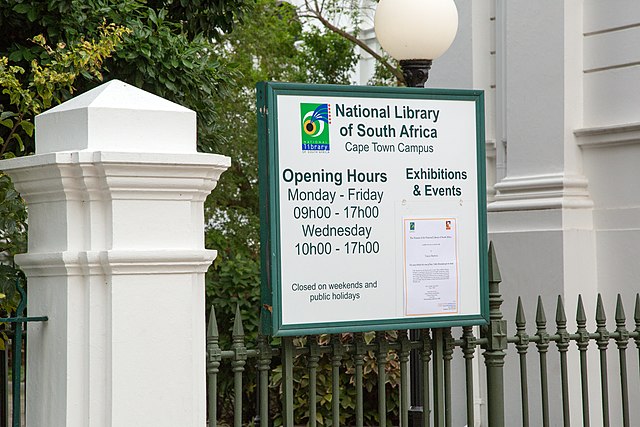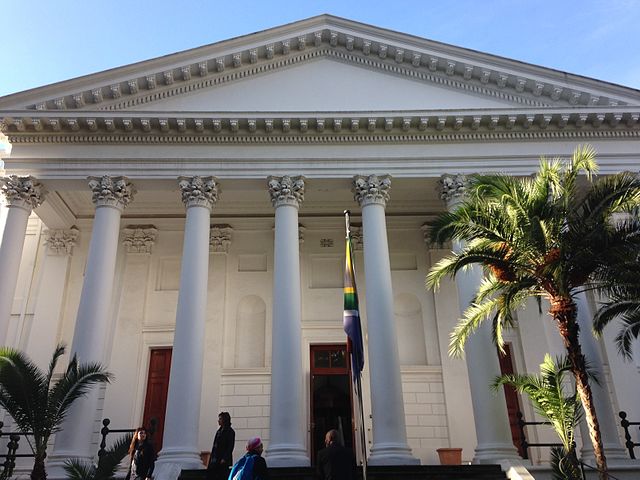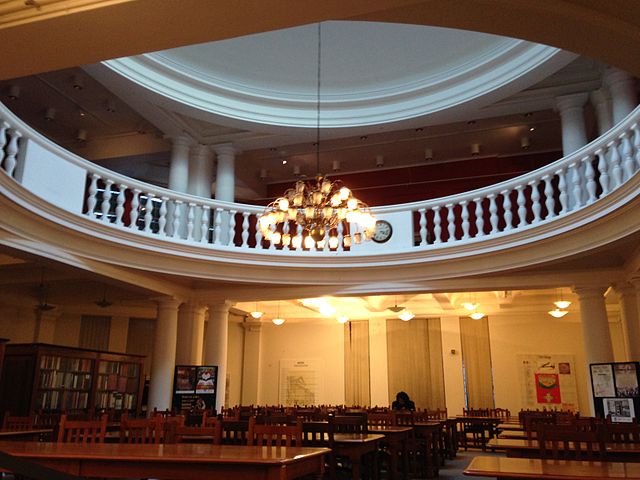National Library of South Africa.
The National Library of South Africa has Cape Town and Pretoria campuses. Its central location is in Pretoria, Gauteng Province, the administrative capital of South Africa. Pretoria is a research center, with three universities as well as the Council for Scientific and Industrial Research (CSIR) located nearby. Pretoria is called Jacaranda City, after a purple flowering plant also found in Nepal, Australia, and other regions. According to its website, the library’s mission is to serve
as the primary resource and custodian of South African documentary heritage, promotes creative, effective and efficient universal access to information.
As custodian and provider of the nation’s key knowledge resources, the library is mandated to collect and preserve published documents and make them accessible. We ensure that knowledge is not lost to posterity and that information is available for research.
Until 1999, South Africa had two national libraries, the South African Library founded in 1818 in Cape Town, and the State Library founded in 1887 in Pretoria. These two institutions joined together in November 1999 as the National Library of South Africa, with over 2.6 million items. Back in 1818, the governor of the Cape Colony decided to require a tax on wine to pay for a South African Public Library to bring knowledge to young people and make home education possible. Among important early donors was Sir George Grey, a British soldier who had served as governor of Cape Colony in the 1800s. He presented his collection of medieval and Renaissance manuscripts and rare books to the library. These include some 5,000 volumes, with over 100 medieval and Renaissance manuscripts. A copy of the Gospels in Latin, made around the year 900 CE, rates as the oldest manuscript in Southern Africa. The State Library of the South African Republic was created with a donation of books from the Society of Dutch Literature (MNL), based in Leiden, the Netherlands, since the 1700s. The first national librarian was Jan F.E. Celliers (1865-1940), an Afrikaans-language poet, essayist, and playwright. Celliers innovated and built the collection by exchanging all official publications with the Smithsonian Institution, Washington, D. C. Later, Matthew Stirling (1889-1965) tried to establish a system of public libraries in South Africa following the model of American libraries, with advice from the Carnegie Corporation of New York. Stirling also promoted reading facilities for South African people of color.
Collecting
Among its many and diverse collections, the library owns the first South African newspaper, dating back to 1800. It has many other periodicals from the 1800s from South Africa and overseas. Most of these are in the humanities, but it also has scientific journals starting in the 1700s. The library has an extensive manuscripts collection of documents and letters of historical and literary importance. Among these are many by Olive Schreiner (1855-1920), the novelist, feminist, and social theorist. A guide to Olive Schreiner’s feminism is in the collection of the Thammasat University Libraries. Among other manuscripts are writings by Uys Krige (1910–1987) an anti-Fascist South African in the Afrikaans and English languages. Apart from his own novels and other books, Krige translated into the Afrikaans language plays by Shakespeare and poetry by Federico García Lorca, Pablo Neruda, Lope de Vega, Juan Ramón Jiménez, Charles Baudelaire, François Villon, Jacques Prévert, Arthur Rimbaud, Paul Éluard, Salvatore Quasimodo, and Giuseppe Ungaretti. The library also owns sketches and travel accounts of South Africa dating back to the 1600s. These include works by Hendrik Claudius, a German painter who came along on a scientific expedition to make sketches of unusual plant and animal life, and anonymous drawings from around 1700 of the Khoikhoi people of southwestern Africa, the first native people to have contacts with Dutch settlers in the mid-1600s. The map collection features an atlas published in the 1600s by the noted cartographer Gerardus Mercator. There are special collections of books about cooking, etiquette, mountain climbing, chess problems, and many other topics.
Preserving.
The National Library is a partner with the National Digital Imaging Project of South Africa (DISA) on a project entitled South Africa’s Struggle for Democracy: Anti-Apartheid Periodicals, 1960-1990 in which digital copies are being made of scarce periodicals published during the three key decades in the growth of opposition to apartheid rule, a period when the African National Congress (ANC), black consciousness, and other resistance movements were very active. Approximately forty periodical titles have been selected from a comprehensive list, representing not only a wide spectrum of political views published during these years, but also a diversity of subjects such as trade unions, religion, health, culture, and gender.
Another concern is acidity in paper which leads to deterioration. Of over 500,000 South African publications in the collection, as many as 60 percent may be threatened by paper deterioration. A de-acidification facility is included as part of the library in Pretoria to help resolve this issue. The Conservation Department is involved with bookbinding and book repairs, among other activities. The National Librarian and CEO is Professor Rocky Ralebipi-Simela, Ph.D. Professor Ralebipi-Simela has worked in higher education in South Africa and the United States, and as an information management specialist. She has served as campus librarian and professor of library and information science at University of St. Catherine, St. Paul and Minneapolis, Minnesota, among other appointments. The library webpage welcoming her arrival in 2014 noted that among her honors,
The most prestigious title she holds, however, is that of grandmother to Mbali and Mpumi.

Thailand and South Africa
The South African Embassy in Bangkok is active in events in Thailand. In September, the South African diplomats Mr. Deon Seals and Mr. George Mello attended Assumption College Primary Section’s Academic Event 2016. Currently, there are seven South African English language teachers at Assumption College. Also in September, Mr. Surapol Yinasawapun, Senior Expert in Plant Quarantine of the Thai Department of Agriculture, met with a South African fruit delegation to examine market access in the Kingdom for apples and pears exported from South Africa. Discussions to further technical cooperation were on the agenda. Opportunities for Thai farmers to export longan and mangosteen to South Africa were also addressed. In April, The Nation reported South African Freedom Day was celebrated at The Rain Tree Café in the Plaza Athénée Bangkok, by South African guest chefs Mike Williams, 59 and Daniel Williams. They prepared such typical dishes as pickled fish, butternut soup, Durban chicken curry bunny chows, lamb breedie (tomato lamb stew), and pumpkin fritters for diners. A barbeque with kebabs and South African sausage was also featured, followed by desserts, including koeksisters (syrup infused doughnut), melk tart (milk tart), peppermint crisp tart and Hertzoggies (jam and coconut meringue tarts).
(All images courtesy of Wikimedia Commons)



